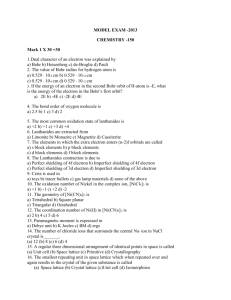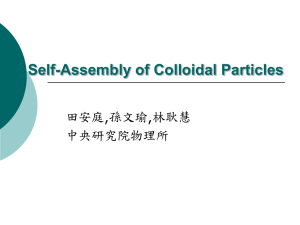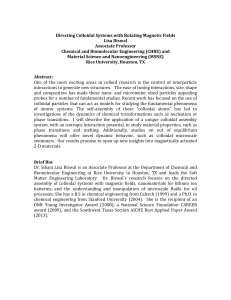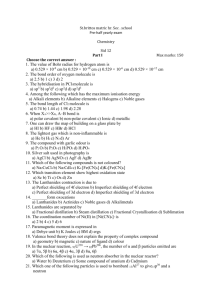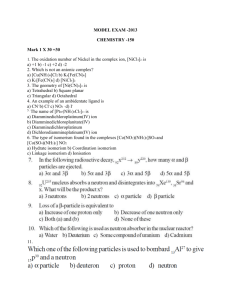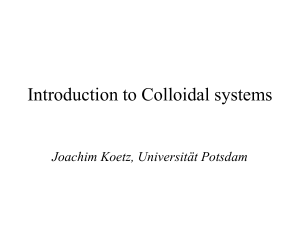Chemistry-150-Marks3hrs
advertisement
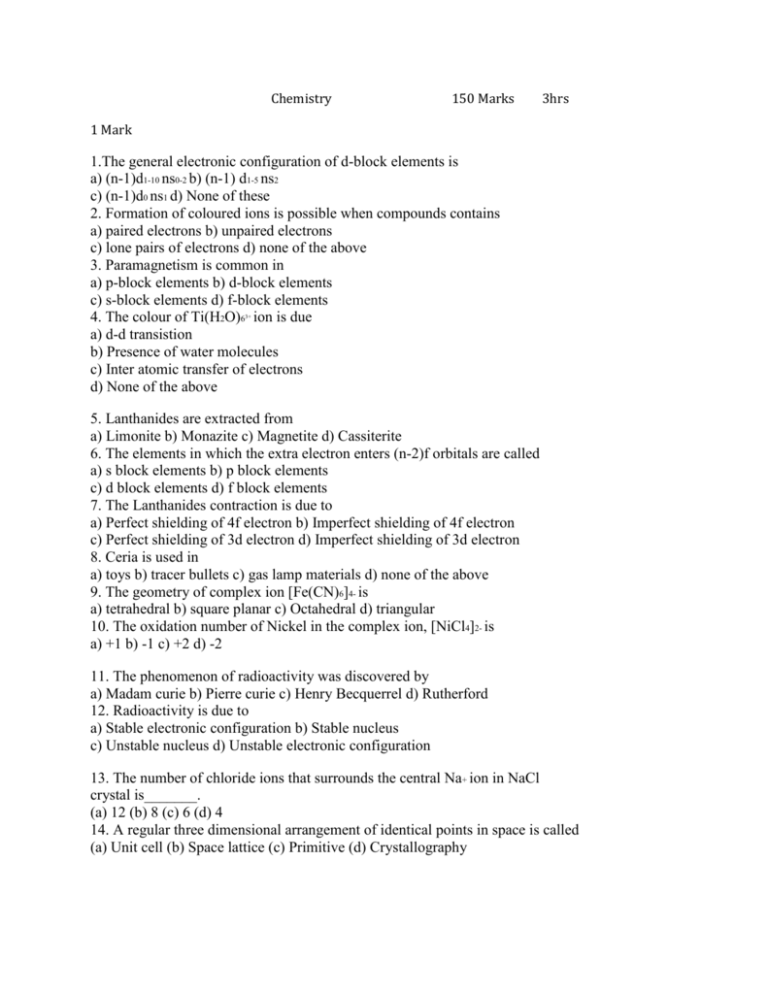
Chemistry 150 Marks 3hrs 1 Mark 1.The general electronic configuration of d-block elements is a) (n-1)d1-10 ns0-2 b) (n-1) d1-5 ns2 c) (n-1)d0 ns1 d) None of these 2. Formation of coloured ions is possible when compounds contains a) paired electrons b) unpaired electrons c) lone pairs of electrons d) none of the above 3. Paramagnetism is common in a) p-block elements b) d-block elements c) s-block elements d) f-block elements 4. The colour of Ti(H2O)6 ion is due a) d-d transistion b) Presence of water molecules c) Inter atomic transfer of electrons d) None of the above 3+ 5. Lanthanides are extracted from a) Limonite b) Monazite c) Magnetite d) Cassiterite 6. The elements in which the extra electron enters (n-2)f orbitals are called a) s block elements b) p block elements c) d block elements d) f block elements 7. The Lanthanides contraction is due to a) Perfect shielding of 4f electron b) Imperfect shielding of 4f electron c) Perfect shielding of 3d electron d) Imperfect shielding of 3d electron 8. Ceria is used in a) toys b) tracer bullets c) gas lamp materials d) none of the above 9. The geometry of complex ion [Fe(CN)6]4- is a) tetrahedral b) square planar c) Octahedral d) triangular 10. The oxidation number of Nickel in the complex ion, [NiCl4]2- is a) +1 b) -1 c) +2 d) -2 11. The phenomenon of radioactivity was discovered by a) Madam curie b) Pierre curie c) Henry Becquerrel d) Rutherford 12. Radioactivity is due to a) Stable electronic configuration b) Stable nucleus c) Unstable nucleus d) Unstable electronic configuration 13. The number of chloride ions that surrounds the central Na+ ion in NaCl crystal is_______. (a) 12 (b) 8 (c) 6 (d) 4 14. A regular three dimensional arrangement of identical points in space is called (a) Unit cell (b) Space lattice (c) Primitive (d) Crystallography 15. The amount of heat exchanged with the surrounding at constant temperatureand pressure is called a) ΔE b) ΔH c) ΔS d) ΔG 16. All the naturally occuring processes proceed spontaneously in a direction which leads to a) decrease of entropy b) increase in enthalpy c) increase in free energy d) decrease of free energy 17. The term A in Arrhenius equation is called as (a) Probability factor (b) Activation of energy (c) Collision factor (d) Frequency factor 18. The sum of the powers of the concentration terms that occur in the rate equation is called (a) molecularity (b) order (c) rate (d) rate constant 19. The migration of colloidal particles under the influence of an electric field is known as (a) electroosmosis (b) cataphoresis (c) electrodialysis (d) electrophoresis 20. Which one is the correct factor that explains the increase of rate of reaction by a catalyst (a) shape selectivity (b) particle size (c) increase of free energy (d) lowering of activation energy 21. Fog is a colloidal solution of (a) gas in liquid (b) liquid in gas (c) gas in solid (d) solid in gas. 22. The phenomenon of Tyndall’s effect is not observed in (a) emulsion (b) colloidal solution (c) true solution (d) None 23. The Tyndall’s effect associated with colloidal particles is due to (a) presence of charge (b) scattering of light (c) absorption of light (d) reflection of light 24. Indicators used in acid-base titrations are ........... (a) strong organic acids (b) strong organic bases (c) weak organic acids or weak organic bases (d) non-electrolysis 25. For the titration between oxalic acid and sodium hydroxide, the indicator used in ........... (a) potassium permanganate (b) phenolphthalein (c) litmus (d) methyl orange 26. The feasibility of a redox reaction can be predicted with the help of (a) Electronegativity (b) Electrochemical series (c) Electron affinity (d) Equivalent conductance 27. The metals near the bottom of the electrochemical series are (a) strong reducing agents (b) strong oxidising agents (c) weak reducing agents (d) weak oxidising agents 28. The emf of a cell with 1 M solutions of reactants and products in solution at 25o C is called (a) Half cell potential (b) Standard emf (c) Single electrode potential (d) Redox potential 29Diazonium salts give coupling reactions with (a) alcohol (b) aromatic amines (c) all amines (d) amines and phenols 30.Substances which bring the body temperature down to normal temperature are known as (a) antipyretics (b) analgesics (c) antibiotics (d) none 3Marks 15 X 3 =45 1.How are d-block elements classified? 2.zn2+ salts are white Ni+2 salts are colored. Why? 3.(Ti(H2O)6)3+ is colored while (Sc(H2O)6)3+ is colorless.Explain. 4.Explain why the melting and boiling points of Zn,Cd,Hg are low? 5.Why do transition elements form complexes? 6.What is meant by nuclear fission? 7.Explain the use of radioactive isotope in the mechanism of photosynthesis in plants. 8.Give two example for AB and AB2 type ionic crystals. 9.What is coordination number? 10.How is ΔG related to ΔH and ΔS? What is the meaning of ΔG =0? 11. Calculate the entropy changes in the system, and in the surroundings and the total entropy change in the universe when during a process 75 J of heat flow out of the system at 55oC to the surroundings at 20oC. 12.Derive the relationship between half life period and rate constant to a firs order reaction. 13.What is activation energy? 14.What is pseudo first order reaction? 15.Whatare simple and complex reactions? 16.What are active centers? 17.Colloidal system of gas in gas does not exist. Why? 18.What happens when anisole is treated with Lewis acid? 19.Write a note on williamson synthesis? 20.Define Chemotherapy? 5 Marks: 7 X5 =35 1.` Explain briefly the extraction of copper from its chief ore. 2.Name the ores of gold .Explain how it is extracted from its alluvial gravel. 3.What is lanthanide contraction? Discuss its causes and consequences. 4.Compare and contrast the properties of lanthanides and actinides. 5.Explain coordination and ionization isomerism with suitable examples. 6.Explain the Bragg’s spectrometer method. 7.Calculate the entropy increase in the evaporation of 1 mole of a liquid when it boils at 1000C having heat of vaporization at 1000C as 540 cals/gm. 8.State and Explain kohlrausch’s law. 9.How emf of a cell is determined? 10.Write the possible Isomers for the formula C7H80. 10Marks 4X10 =40 1.a)Write all possible isomers with molecular formula C4H10O and name them b)Illustrate electrophilic substitution reaction of anisole. 2) Explain about a) analgesicsb)antipyretics c)antibiotics d)antioxidants e)antiseptic. 3)a) The standard electrode potentials of the half cells Ag+ / Ag and Fe3+, Fe2+ / Pt are 0.7991 V and 0.771 V respectively. Calculate the equilibrium constant of the reaction : b) Calculate the E.M.F. of the zinc - silver cell at 25oC when [Zn2+] = 0.10 M and [Ag+] = 10 M. (Eo cell at 25oC = 1.56 volt] 4) a)What are spontaneous reactions?What are the conditions for the spontaneity of a process? b)Explain about the characteristics of free energy G. 5)a)Explain thee postulates of werner’s theory. b)What is electro –osmosis? Explain 6)Write notes on i)Dialysis ii)Electrodialysis iii)ultrafiltration iv)Brownian movement. 7)a)what is bragg’s equation?. Give its significance. b) Half-life period of a radioactive element is 100 seconds. Calculate the disintegration constant and average life period. How much time will it take for 90% decay?
